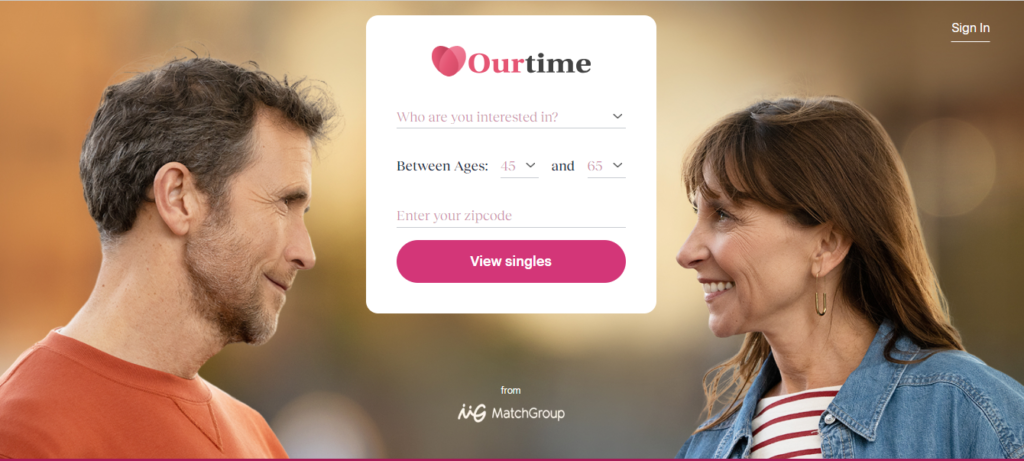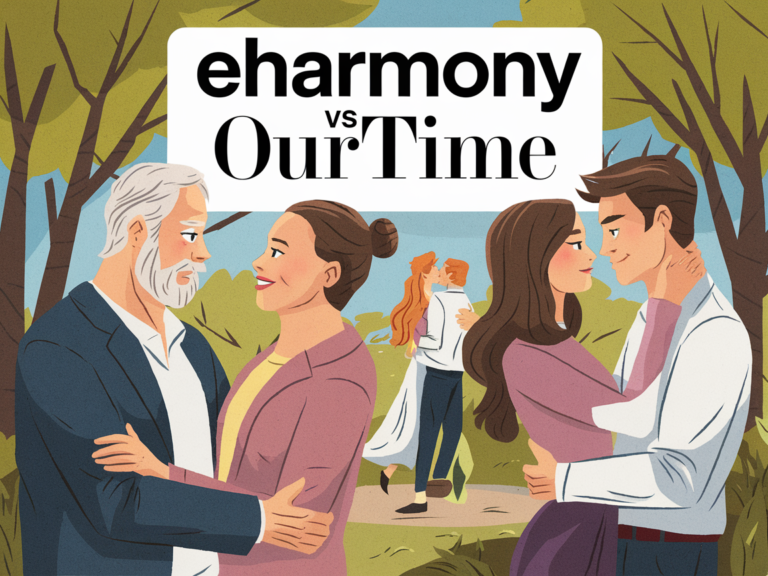With the rise of online dating, singles now have endless options when searching for a soulmate. However, the broad selection of dating sites and apps can feel overwhelming.
Should you choose a popular app like Tinder or Hinge that casts a wide net? Or is a niche, targeted site like OurTime better suited for your needs?
To help cut through the confusion, we compared two of the most popular dating sites for serious relationships – eHarmony and OurTime.
While both platforms aim to match members based on shared interests and compatibility, they each offer unique features and target demographics.
Read on as we break down their key similarities and differences to help you determine which service provides the best fit.
(If you’re also considering other popular options, you might want to check out our eHarmony vs Match comparison for another perspective on top dating sites.)
A Brief Overview of eHarmony and OurTime
What is eHarmony?

Established in 2000, eHarmony utilizes a proprietary matching system based on scientific principles to connect compatible singles seeking meaningful relationships.
The sign-up process includes an extensive personality questionnaire designed by eHarmony’s founder Dr. Neil Clark Warren. The quiz analyzes your traits, interests, values, and goals to find matches that have the best chance at long-term compatibility.
With 20+ years of perfecting their highly-targeted matching algorithm, eHarmony facilitates over 500 marriages in the U.S. every single day. Impressive!
Many users wonder “Is eHarmony worth it?” given its unique approach and success rate.
What is OurTime?

Launched in 2011, OurTime is an online dating community designed specifically for singles over 50. Using a simpler matching process than eHarmony, it helps mature men and women find second love by connecting them with age-appropriate dates.
The streamlined sign-up takes just minutes. You can browse member profiles in your area and communicate via instant messenger without completing lengthy questionnaires or exams. OurTime also offers an iOS app in addition to the desktop site.
Now that you’re acquainted with both services, let’s see how they stack up across key dating criteria.
Main Differences Between eHarmony and OurTime
While eHarmony and OurTime share similarities, some major differences set them apart:
- Target Demographic: eHarmony members must be at least 18-years-old. OurTime requires users to be 50 or older.
- Registration Process: eHarmony has an extensive sign-up process with personality assessments. OurTime sign-up takes just minutes.
- Size of User Base: With 20+ years under its belt, eHarmony definitely wins when it comes to reach. But OurTime sees impressive site traffic as the leading 50+ dating site.
- Matching Approach: eHarmony uses science-based analytics to determine connections. OurTime takes a more simplified approach.
- Membership Fees: Both sites offer free browsing but charge for fully unlocking features. eHarmony offers the most affordability for serious daters.
Let’s explore each of these comparisons more closely:
1# Demographic Focus
The most obvious difference is the fact OurTime exclusively serves the 50+ community, whereas eHarmony members can be 18+.
OurTime recognizes that mature daters have unique needs and preferences compared to their younger counterparts. From life experience compatibility to considerations regarding aging parents or grandchildren, targeting matches by age makes intuitive sense.
That said, some seniors may prefer eHarmony’s broader pool of partners. And if you’re under 50 but seeking an older mate, eHarmony provides that flexibility.
2# The Sign-up Process
Signing up for the two services involves very different processes and time commitments.
eHarmony’s sign-up is quite lengthy, consisting of completing multiple questionnaires examines your personality, values, interests, and relationship goals. While time-consuming, the result is a highly-tailored user profile.
OurTime’s sign-up takes just minutes. After entering your basic personal details, you can immediately view matches and send pre-written “Flirts” to spark conversations.
The quick process lowers the barrier to entry. However, some users may wish OurTime incorporated more assessments to improve match suitability beyond age.
3# Size of User Base
As one of the first mainstream online dating providers, eHarmony’s been building its membership base for over 20 years. The site sees roughly 15 million monthly visitors and boasts being responsible for over half a million marriages in the U.S. alone!
Impressive numbers, though not altogether surprising. Their trademark compatibility test and algorithm for creating fulfilling relationships are major draws.
But even as a newer, niche site, OurTime has quickly gained traction. It clocks over 1.4 million visitors per month, making it the leading 50+ dating platform by a wide margin.
The targeted age focus clearly caters to an underserved market of mature singles looking to make meaningful connections.
4# Matching Methodology
As outlined above, eHarmony and OurTime approach matchmaking quite differently.
eHarmony bases compatibility on psychological assessments developed by relationship expert Dr. Neil Clark Warren. The in-depth “29 Dimensions of Compatibility” model matches couples on shared personality traits, values, and interests scientifically linked to relationship success.
OurTime takes a streamlined approach. Users specify partner preferences like age range, location, relationship type, and ethnicity to instantly view local suggestions. Advanced paid members can further filter by keywords like “likes pets” or “enjoys cooking.”
Both approaches have merits and limitations. Guaranteed 100% compatibility is rare, so finding satisfying suggestions often requires some trial and error browsing.
5# Membership Fees
eHarmony and OurTime follow a “freemium” model: users can browse basic profiles or take compatibility quizzes for free, while advanced messaging and searches require paid unlocking.
For serious daters, eHarmony offers excellent overall value, with subscription lengths spanning 1-24 months. Monthly costs can be as low $12.99 with an annual contract.
OurTime’s membership options are more limited: pay $17.98 monthly or $11.98 monthly for a year’s subscription. They also aggressively upsell à la carte features like attaching video profiles or spotlighting your account.
While eHarmony isn’t cheap, you get what you pay for — access to millions of like-minded relationship-seekers and science-based matching capabilities.
For budget-focused boomers, OurTime’s simpler (and less proven) model merits consideration. But be prepared to sift through more trial-and-error matches and lackluster feature offerings.
(If you’re interested in exploring no-cost alternatives, check out our guide to the best free dating sites for serious relationships.)
Which Mature Dating Site is the Right Fit?
At the end of the day, choosing between industry leader eHarmony versus targeted platform OurTime depends on your unique dating preferences and budget.
Ask yourself:
- Am I interested in the most extensive compatibility matching and profile options? eHarmony
- Is cost my main concern when finding 50+ compatible matches? OurTime
- Do I prefer streamlined browsing and messaging without lengthy sign-up quizzes? OurTime
We hope mapping out their key specs clears up the confusion surrounding these two popular relationship-focused dating sites.
Whichever you choose, may your next first date be just a click away!

